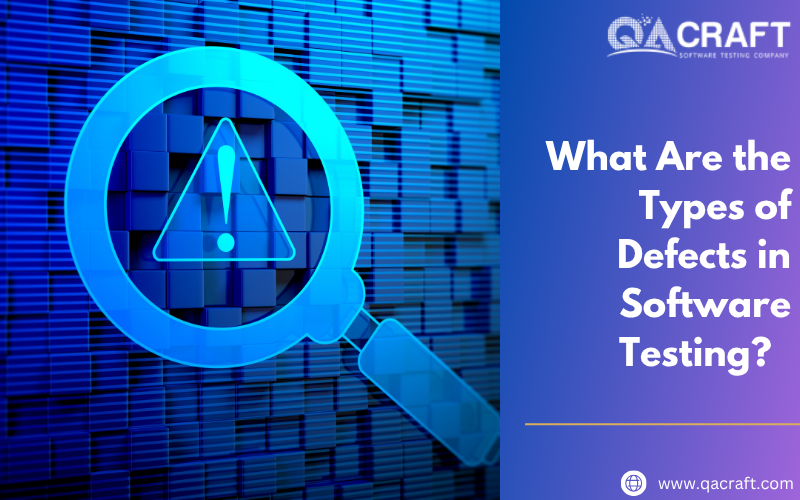19 Jun

Developing any application requires a certain amount of software testing and validation. And so, it guarantees the software is working as intended and fulfills the needs of the users. But defects (or bugs) are usually discovered in between. Through the testing, bugs will get discovered and identified, causing performance, security, and functionality issues.
Various Kinds Of Defects In Software Testing and How They Affect The Software
⟹ Functional Defects
Functional defects are when the software behaves unexpectedly. This may mean a feature doesn’t work at all or doesn’t function the way it should. You can consider that a functional defect, for instance, if you are using some shopping application and the payment gateway does not work, or any item you add to your cart does not appear
FDDs are common when requirements were either misinterpreted or not executed as specified.
⟹ Performance Defects
Performance defects are problems in a software system that work but fail to do so in an effective manner. Such problems can involve slow loading, delays, or crashes with high traffic. But imagine an online exam portal that crashes when too many users log in at once. This is a performance defect.
These defects are important because they can annoy users, make them abandon the app, and earn the software a poor reputation.
⟹ Security Defects
Security defects are vulnerabilities in the software that can be used by attackers. These vulnerabilities can result in data breaches, unauthorized access, or exposure of sensitive information. For instance, if a banking application fails to securely encrypt account information or personal details, there is a vulnerability in the system. Cybercrimes are ever-growing, and fixing security defects has become a high priority for software testers.
⟹ Usability Defects
Usability defects pertain to the user experience (UX) of the software. The application becomes difficult to use and confusing for the user because of these defects. It includes stuff like hard-to-read text, confusing navigation, or buttons that don’t do what you expect.
A complex checkout process of an e-commerce website is an example that can upset the customers, and they would leave the portal without purchasing.
⟹ Compatibility Defects
These defects happen when the software doesn’t perform well on other devices, browsers, or operating systems. For instance, a mobile app that runs like a dream on an Android device but crashes a day after the app is installed on iOS. Compatibility issues may also occur when the software doesn’t function well on another version of a browser or operating system.
Avoiding these kinds of defects is necessary to test the software across different platforms and devices.
⟹ Regression Defects
Regression: When a new change or feature in the software causes a bug in a previously working part of the application. So, instead of that chat feature, after the new feature was added to a messaging app, you may suddenly find that chat feature to be non‐functional.
To ensure that the existing functionality of the software is not broken, regression testing is performed by testing teams or developers.
⟹ Interface Defects
When parts of the software or external systems do not communicate properly.
Example: If the payment app’s communication with the bank’s server is not handled properly, that’s an interface defect.
Some of the defects mean that the application is unable to send or receive correctly in transactions or warrants.
⟹ Data Defects
This is when the software does something wrong with the data (the input). Such problems can involve data being displayed incorrectly or data being lost while being processed. If you are using a banking app and it shows incorrect balances for your accounts or transactions, that is a data defect.
Data defects are serious, especially when handling sensitive or crucial information.
⟹ Logical Defects
Logical flaws: These are errors in the way the software’s algorithms function. For instance, an e-commerce site could be showing products in an incorrect sorting or filtering order. These types of defects are not easy to find because they are not as clear as functional mistakes, but they can lead to an erroneous result.
⟹ Critical Defects
So critical defects are the most severe defects, which cause the software to crash, or they are preventing users from completing any important tasks. For instance, a crash occurring during an app’s login attempt is an absolute defect. They need fixing, and they can stop the entire working of the software.
Conclusion
Their importance in the software development process was undeniable, as they needed to be identified, compared, and fixed. Knowing what types of defects to expect (functional, performance, security, usability, compatibility, regression, interface, data, logical, and critical, etc.) can help streamline software testing and deliver a quality product.
Software must be free from bugs, which is essential in an ever-growing digital world. Thus, software testers are responsible for identifying and rectifying these defects before the product is released to the end user. Thus, no matter if you are a developer or a tester, always perform testing on the software to check whether your software is working well to meet users’ expectations.



Twisa Mistry